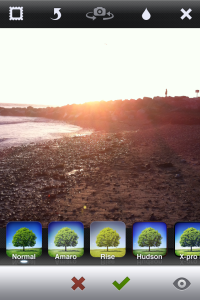
Instagram is iPhone’s most popular photo taking/editing app that is available to iPhone users. It is a free app that allows you to take or use existing photos on your iPhone’s camera roll and place varying filters onto the photo to change the appearance of the image. It also allows you to add a ’tilt shift’ onto the image, creating a blurred effect. Having created your image so easily, you are then able to tag the location you took the photo and upload it onto your Instagram feed. Instagram also allows you to ‘follow’ fellow Instagram user so you are able to keep track on other’s images and decide whether you wish to leave a comment on that image, ‘like’ it or to simply enjoy the photographs that other enthusiasts create and upload. When uploading your image onto Instagram you are also able to upload to Facebook, Twitter etc. at the same time. Being able to share your images has become increasingly easy and convenient.
These are a few screen shots from my Instagram feed:

This is a screen shot from my own Instagram feed. This is one of my own own images that I uploaded – It shows my user name on Instagram, the location that I tagged on it, which is where I took it. And underneath the image it shows the ‘greengoeskiwi’ ‘likes’ my image. It also shows how long ago I uploaded it too at the top right.

A good thing with Instagram’s popularity is that celebrities even join in with the photo sharing, such as Jamie Oliver. You can ‘follow’ them and see what they are getting up to too. Leaving comments and the choice of ‘liking’ it too.

This is a photograph taken by my boyfriend, which again shows his user name, time uploaded and underneath the image it shows that I have ‘liked’ the image.
I love this app, it by far my favourite iPhone app!! The effects you can get with it can be really amazing. I find myself using it a lot, even if it’s just to see what other people have been up to.
These are examples of my own Instagram images:








To show how easy it is I have done some screen shots on my phone showing the process in making an Instagram image:

Take a photograph or select an existing photograph on your camera roll and scale the image to your specifications and then push ‘Choose’.



Here, you are able to scroll through the varying filters that can be put onto the image, there are currently 16 to choose from. You are also able to add the ’tilt shift’ effect too, which is the teardrop symbol at the top along the black banner. You also have the option to remove the frame that is put around the image with each filter, this is the square symbol at the top left of the black banner.

The eye at the bottom right of the screen allows you to see the image without the filter panel in the way. The red cross allows you to go back and choose another image and the green tick proceeds you to the next step…

Here, you are able to add a caption to the image, Geotag the image to the location where you took it, and to select options if you wanted to upload to Twitter or Facebook, email the image etc. Once selections have been made (if wanted) touch ‘Done’ at the top right of the screen.

The image then appears on your feed page, where people who are following you can see it. Simple!!!
































